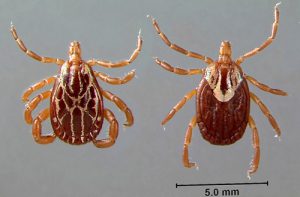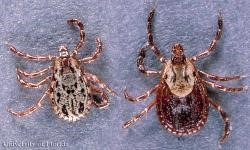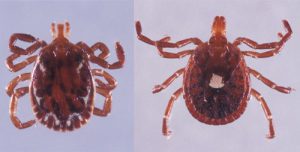As the weather continues to warm up and we all start looking for a shady spot under the trees, some of us will experience the not so nice effect of ticks and their itchy bites. This can be even more worrisome if you have children or pets, who may not notice them as quickly. Ticks are not insects and are closely related to the spiders. Adult ticks have eight legs. Their life cycle is divided into four stages: egg, larva, nymph, and adult. Ticks can lay thousands of eggs in a season; the larvae are approximately 0.5mm in size. These baby ticks are often referred to as seed ticks and if you are the unlucky individual to bump into a nest of them you will usually have many, sometimes hundreds, of them on you. Ticks are external parasites that feed on a variety of birds and mammals, and happily bite humans. Ticks feed by making a small hole in the skin, attaching themselves with a modification of one of the mouthparts, which has teeth that curve backwards, and inserting barbed, piercing mouthparts to remove blood.
Types of Ticks

Black Legged Ticks or deer ticks are a primary transmitter of Borrelia burgdorferi, the causative agent of Lyme disease. They primarily exist in the Northeastern United States, but their distribution is spreading and they are found in Florida. Their primary host is white-tail deer; however, nymphs commonly feed on birds, small mammals, and people. Human exposure to black legged ticks is greatest during the summer months when high nymph activity and human outdoor activity coincide.

Gulf Coast Ticks are found in grass prairies and coastal uplands throughout Florida and the Southeastern United States. Gulf Coast ticks are of increasing concern because of their ability to transmit several pathogens of veterinary and medical importance including Rocky Mountain spotted fever, heartwater in ruminants, and can cause canine tick paralysis.

The American Dog Tick occurs throughout the United States and in certain areas of Canada and Mexico. It is found most frequently on dogs, but will also attack larger animals, such as cattle, horses, and humans. This tick lives in wooded, shrubby and long-grass areas. However, it may also be attracted to shrubs, weeds, tall grass, clutter and debris on residential property where rodents may exist as hosts for immature ticks. It can transmit Rocky Mountain spotted fever (RMSF), tularemia, and can cause canine tick paralysis. While the American dog tick can be managed without pesticides, when necessary a recommended acaricide is an effective way of eliminating an existing tick infestation near residences. Adult ticks may move to the edge of the roads or trails in an attempt to find a host. After five to 14 days of blood feeding, a fully engorged female drops from the host, digests the blood meal and develops her egg clutch over the next four to 10 days. She then lays anywhere from 4,000 to 6,500 eggs on the ground. After hatching, larvae remain on the ground or climb growing vegetation where they wait for small mammals, such as mice; depending on environmental conditions, larvae may survive up to 11 months without feeding.

The Brown Dog Tick primarily bites dogs and rarely transmits disease to humans; however, it commonly infests homes. The adult female tick lays a mass of 1,000 to 3,000 eggs after engorging on a dog’s blood. These eggs are often found in cracks on the roof of kennels or high on the walls or ceilings of buildings. In the house, eggs are laid around baseboards, window and door casings, curtains, furniture, and edges of rugs. The egg-laying females are often seen going up walls to lay eggs. If you find brown dog ticks on your pets, both topical and oral pesticides are available from your veterinarian and can help prevent and infestation in your home.

The Lone Star Tick was first considered a nuisance as it is not a transmitter of Lyme disease, but it can transmit various other pathogens to humans and other animals, such as those that cause ehrlichiosis, rickettsiosis, tularemia, and theileriosis. Primary hosts include white tail deer and wild turkeys.
Controlling ticks in your yard:
Habitat modification is the best method to manage ticks. Mowing, removing leaf litter and undergrowth, and using selective herbicides to reduce brush and weedy areas that can provide a refuge for ticks is essential to decreasing exposure to ticks. Ticks require a host to move them from one area to another, so it is important to not welcome in unwanted wildlife and regularly check pets who might enter tick infested areas. People entering tick prone areas should keep clothing buttoned, shirts inside trousers, and trousers inside boots. Do not sit on the ground or on logs in bushy areas and wear repellent on skin or clothes.
Removal: Ticks should not be removed by handpicking because infected tick secretions can be transferred from a person’s hands to his or her eyes, mucous membranes, mouth, etc. To properly remove a tick, grasp the mouthparts near the attachment site firmly with tweezers. Once the mouthparts are held, the tick should be pulled straight back slowly to ensure the entire mouthparts are removed from the body. The area of the bite should be cleaned well and keep a close eye for any signs of infection in which case you should contact your doctor.
Lyme disease is transmitted by ticks, but few cases have been reported in Florida. The primary vector is the deer tick which is not prevalent in Florida. Species that are close relatives and are capable of transmitting Lyme disease are common throughout the state. The American dog tick and the brown dog tick are not considered important vectors of Lyme disease. In cases where Lyme disease is suspected, a physician should be contacted so appropriate blood tests can be done.
 0
0
